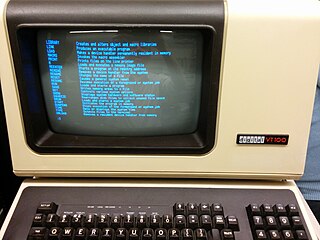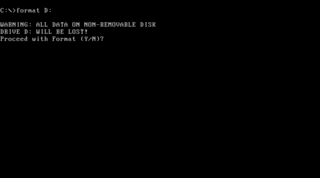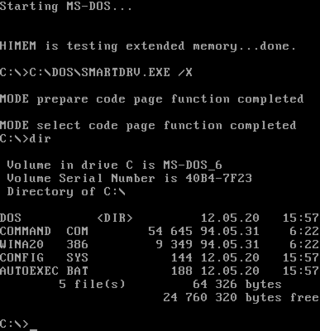
CP/M, originally standing for Control Program/Monitor and later Control Program for Microcomputers, is a mass-market operating system created in 1974 for Intel 8080/85-based microcomputers by Gary Kildall of Digital Research, Inc. Initially confined to single-tasking on 8-bit processors and no more than 64 kilobytes of memory, later versions of CP/M added multi-user variations and were migrated to 16-bit processors.
A beep is a short, single tone, typically high-pitched, generally made by a computer or other machine. The term has its origin in onomatopoeia. The word "beep-beep" is recorded for the noise of a car horn in 1929, and the modern usage of "beep" for a high-pitched tone is attributed to Arthur C. Clarke in 1951.

São José dos Campos is a major city and the seat of the municipality of the same name in the state of São Paulo, Brazil. One of the leading industrial and research centers with emphasis in aerospace sciences in Latin America, the city is located in the Paraíba Valley, between the two most active production and consumption regions in the country; São Paulo and Rio de Janeiro. It is the main city of the Metropolitan Region of Vale do Paraíba e Litoral Norte. A native of São José dos Campos is called a joseense. Being the second most populous non-capital city in Brazil – behind Campinas – São José dos Campos lies in the middle of the Expanded Metropolitan Complex, the first megalopolis in the Southern Hemisphere, with over thirty million inhabitants. The city's metro area also includes Greater São Paulo, Campinas, Santos and Sorocaba. The municipality concentrates many major companies and industries, such as Embraer, Panasonic, Johnson & Johnson, Ericsson, Philips, General Motors, Petrobras, Monsanto among others. São José dos Campos also holds relevant education and research institutions, as ITA, INPE, CEMADEN, IEAv, IEA, IFI, UNESP, UNIFESP, DCTA, FATEC, UNIVAP and IP%D, holding a position the puts the city as the main and largest Aerospacial Complex in Latin America. Thus, it is also considered the warlike producer centre. The Technological Park, the largest one in the country, is the only research institute in the world that converges all the three top global plane production companies, Embraer, Boeing and Airbus.

Multiuser DOS is a real-time multi-user multi-tasking operating system for IBM PC-compatible microcomputers.

DOS Plus was the first operating system developed by Digital Research's OEM Support Group in Newbury, Berkshire, UK, first released in 1985. DOS Plus 1.0 was based on CP/M-86 Plus combined with the PCMODE emulator from Concurrent PC DOS 4.11. While CP/M-86 Plus and Concurrent DOS 4.1 still had been developed in the United States, Concurrent PC DOS 4.11 was an internationalized and bug-fixed version brought forward by Digital Research UK. Later DOS Plus 2.x issues were based on Concurrent PC DOS 5.0 instead. In the broader picture, DOS Plus can be seen as an intermediate step between Concurrent CP/M-86 and DR DOS.
SOX is a discontinued UNIX clone. It was developed from scratch in Brazil, in the late 1980s, by Computadores e Sistemas Brasileiros S/A, under the leadership of Ivan da Costa Marques. Certified as UNIX-compatible by X/Open in early 1989, SOX was one of the first re-implementations of UNIX, fully independent of AT&T, that passed the X/Open verification tests, and the only one ever completed entirely outside the United States.
In computing, share is a command for DOS that allows software to perform file locks. Locking files became necessary when MS-DOS began allowing files to be accessed simultaneously by multiple programs, either through multitasking or networking.

In computing, tree is a recursive directory listing command or program that produces a depth-indented listing of files. Originating in PC- and MS-DOS, it is found in Digital Research FlexOS, IBM/Toshiba 4690 OS, PTS-DOS, FreeDOS, IBM OS/2, Microsoft Windows, and ReactOS. A version for Unix and Unix-like systems is also available.

Luiz Alberto de Vianna Moniz Bandeira was a Brazilian writer, professor, political scientist, historian and poet.
In computing, sys is a command used in many operating system command-line shells and also in Microsoft BASIC.
The DOS API is an API which originated with 86-DOS and is used in MS-DOS/PC DOS and other DOS-compatible operating systems. Most calls to the DOS API are invoked using software interrupt 21h. By calling INT 21h with a subfunction number in the AH processor register and other parameters in other registers, various DOS services can be invoked. These include handling keyboard input, video output, disk file access, program execution, memory allocation, and various other activities. In the late 1980s, DOS extenders along with the DOS Protected Mode Interface (DPMI) allow the programs to run in either 16-bit or 32-bit protected mode and still have access to the DOS API.

In computing, the print command provides single-user print spooling capability in a number of operating systems. It is roughly similar to that provided by the UNIX System V lp and BSD lpr print spooler systems.

In computing, format, a command-line utility that carries out disk formatting. It is a component of various operating systems, including 86-DOS, MS-DOS, IBM PC DOS and OS/2, Microsoft Windows and ReactOS.

DOS is a family of disk-based operating systems for IBM PC compatible computers. The DOS family primarily consists of Microsoft's MS-DOS and a rebranded version, IBM PC DOS, both of which were introduced in 1981. Later compatible systems from other manufacturers include DR DOS (1988), ROM-DOS (1989), PTS-DOS (1993), and FreeDOS (1998). MS-DOS dominated the IBM PC compatible market between 1981 and 1995.
In computing, diskcopy is a command used on a number of operating systems for copying the complete contents of a diskette to another diskette.
In computing, recover is a primitive file system error recovery utility included in MS-DOS / IBM PC DOS versions prior to DOS 6.0 and a number of other operating systems.
Prológica Indústria e Comércio de Mircrocomputadores, commonly shortened to Prológica, was an influential Brazilian microcomputer company that reached its peak in the mid-1980s, when it ranked third among national companies in the sector.
Sistema 700 was a personal professional microcomputer, introduced by the Brazilian computer company Prológica in 1981.
Solution 16 was a personal computer the first Brazilian all-in-one PC, introduced by Prológica in 1986.









